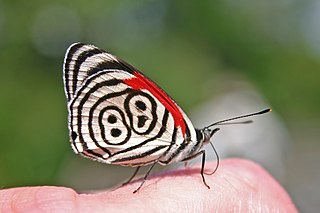Related Research Articles
In Greek mythology, Ceryx was a son of Hermes and either Pandrosus or Agraulus. He was, like his father, a messenger. But the kêryx career began as a humble cook for the tribe, a skill Hermes demonstrates in his cooked meat offerings on the Twelve Gods Altar set in place 522BC by Peisistratos III in Athens. The Homeric Hymn to Hermes 128 recalls the young god cutting out and laying up twelve steaks on a flat rock or platamoni," the 12 Gods altar.

Ceryx is a genus of moths in the family Erebidae. It was described by Hans Daniel Johan Wallengren in 1863.

Diaethria is a brush-footed butterfly genus found in the Neotropical realm, ranging from Mexico to Paraguay.
Similodonta is an extinct genus of early bivalve in the extinct family Praenuculidae. The genus is one of eleven genera in the subfamily Praenuculinae. Similodonta is known from Middle Ordovician through Middle Silurian fossils found in Europe and North America. The genus currently contains eight accepted species, Similodonta ceryx, Similodonta collina, Similodonta djupvikensis, Similodonta magna, Similodonta recurva, Similodonta spjeldnaesi, Similodonta wahli and the type species Similodonta similis.
Ceryx aethalodes is a moth of the subfamily Arctiinae. It was described by Wileman and West in 1928. It is found on the Philippines (Luzon).
Ceryx affinis is a moth of the subfamily Arctiinae. It was described by Rothschild in 1910. It is found in New Guinea.
Ceryx antiopa is a moth of the subfamily Arctiinae. It was described by Sergius G. Kiriakoff in 1953. It is found in the Democratic Republic of the Congo.
Ceryx basilewskyi is a moth of the family Erebidae. It was described by Sergius G. Kiriakoff in 1955. It is found in Burundi.
Ceryx bernhardi is a moth of the subfamily Arctiinae. It was described by Seitz.
Ceryx calcuni is a moth of the subfamily Arctiinae. It was described by Obraztsov in 1957. It is found on Java.
Ceryx carpentieri is a moth of the subfamily Arctiinae. It was described by Abel Dufrane in 1936. It is found in the Democratic Republic of the Congo.
Ceryx diptera is a moth of the subfamily Arctiinae. It was described by Johan Christian Fabricius in 1775. It is found in southern India and Sri Lanka. In male, the body is black. Frons, collar and tegulae are yellow. Forewings with a sub-basal, two medial, one sub-apical and two sub-marginal hyaline (glass-like) spots. Hindwings with a sub-basal joined to a sub-marginal spot. Tarsi black. Female is similar to male, but differ with the abdomen dilated and with a tuft of ochreous hairs.
Ceryx evar is a moth of the subfamily Arctiinae. It was described by Pagenstecher in 1886. It is found on Ambon Island, Aru and the Key Islands.
Ceryx hageni is a moth of the subfamily Arctiinae. It was described by Snellen in 1895. It is found on Sumatra.
Ceryx helodiaphana is a moth of the subfamily Arctiinae. It was described by Roepke in 1937. It is found on Java.
Ceryx keiensis is a moth of the subfamily Arctiinae. It was described by Rothschild in 1910. It is found on the Key Islands.
Ceryx lamottei is a moth of the subfamily Arctiinae. It was described by Sergius G. Kiriakoff in 1963. It was described from Nimba.
Ceryx pleurostictoides is a moth of the subfamily Arctiinae. It was described by Strand in 1915. It is found in Taiwan.
Ceryx salutator is a moth of the subfamily Arctiinae. It was described by Sergius G. Kiriakoff in 1965. It is found in the Democratic Republic of the Congo.
Ceryx sambavana is a moth of the subfamily Arctiinae. It was described by George Hampson.
References
- ↑ Beccaloni, G.; Scoble, M.; Kitching, I.; Simonsen, T.; Robinson, G.; Pitkin, B.; Hine, A.; Lyal, C., eds. (2003). "Ceryx burgeffi". The Global Lepidoptera Names Index . Natural History Museum . Retrieved April 28, 2018.
| This Ceryx-related article is a stub. You can help Wikipedia by expanding it. |